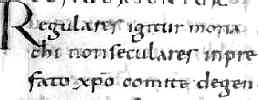|
|
|
|
 |
|
Caroline
Minuscule |
|
The
development of Caroline
Minuscule, or Carolingian minuscule, was a reform which increased
the uniformity, clarity and legibility of handwriting. It was evidently
developed in the late 8th century scriptorium
of Charlemagne, or in those of the monasteries under his patronage, in the course of his conscious efforts to revive the literate
culture of Classical Rome. |
|
Caroline
minuscule was not suddenly invented one rainy afternoon. Changes had been
occurring over time to the Merovingian
and Germanic
minuscules, rendering them neater, rounder and simpler. The new script
spread to various European monastic scriptoria, but in its early phase
these various centres retained certain individualities of style from their
earlier minuscule
book hands. |
 |
|
Sample
of script transitional between Merovingian and Carolingian types, from
an Epistle of Gregory the Great (Cologne Cathedral Library, MS XCI) in
an 8th century volume. |
|
Accompanying
the reform of the minuscule scripts was a return to standard Classical
forms of the majuscule
scripts such as uncial,
and also half uncial,
for display headings. Carolingian books employed a hierarchy of scripts to differentiate heading of different weight and to formalise page layout. |
|
The
Carolingian chancery
did not immediately adopt this new script
for charters or
diplomas, retaining
certain calligraphic
flourishes from Merovingian
chancery script. It is a little intrguing that clarity and legibility seems to have been regarded as less important for legal documents than for liturgy. |
|
In
the early 9th century, the various centres using this script adopted a
more standardised form, abandoning the flourishes and ligatures
of their earlier styles. The monastery of Tours may have been responsible
for spreading this more regular style via the many manuscripts
produced there and sent to other monasteries. |
 |
|
Sample
of early 9th century Caroline minuscule from a Lives of the Fathers (Brussels,
Bibliothèque Royale, MS 8216-18). |
 |
The Ada Gospels of the late 8th century (Treves, Stadtbibliothek, Bibelhandschriften 22 (Codex aureus), p.17). |
|
The
script was adopted in northern Italy in the early part of the 9th century,
building on a base of existing script reform. Insular
minuscule disappeared from the German monasteries of Anglo-Saxon foundation
around the mid 9th century and was replaced by Caroline minuscule. A similar
replacement took place in Brittany which had used its own characteristic
form of insular minuscule. The new style spread as far north as Denmark. |
|
Caroline
minuscule was not adopted in England until the 10th century when it was
associated with the reform of Benedictine monasticism. English Caroline
minuscule retained a certain regional distinctiveness of style, including
the wedge shaped ascenders from the earlier insular minuscule script. |
|
|
Ruins
of St Augustine's Abbey, Canterbury |
 |
Sample
of English Caroline minuscule in the 10th century New Minster Charter (British
Library, Cotton Vespasian A VIII), by permission of the British Library. |
|
|
There
was some variation between large, rounded forms of the script and smaller,
more compact versions. |
 |
|
Rounded
and bold form of Caroline minuscule in the late 10th century Ramsay Psalter
(British Libary, Harley 2904, f.181), by permission of the British Library. |
 |
|
Small
and compact version of Caroline minuscule in a computistical work concerning
calculation of the date of Easter, from the later 11th century (British
Library, Cotton Caligula A XV, f.125v), by permission of the British Library. |
|
In England the
script was used for charters as well as for a book
hand when the language used was Latin. However, insular minuscule
was retained for English documents and books. Bilingual documents or books
used both scripts, so that scribes
were competent in both. |
 |
|
Segment
of a charter of the time of William II, in a clear Caroline minuscule
hand. |
|
Caroline
minuscule gradually replaced Visigothic
script in Spain during the 11th century. Factors affecting its demise
were the expansion of the Cluniacs into the country and the banning of
the native script for ecclesiastical books in 1090 after liturgical reforms. For other works, the letter forms of Caroline minuscule gradually
infiltrated the Visigothic. |
|
The
Merovingian chancery script and its Carolingian successor were retained
in Germany until around the mid 9th century and in France until the 10th
century. The royal document
hand of Germany became closer to the Caroline minuscule book hand,
with some calligraphic flourishes. Private
charters were generally produced in the Caroline minuscule book hand,
often with long ascenders and descenders. |
|
|
Caroline
minuscule eventually became a relatively standardised script over an area
ranging from Spain to Scandinavia, England to northern Italy. It is an
easy script for us to read as the forms of letters are very similar to
those employed today in book typefaces. The adoption of a more standardised
form of writing coincided with an increase in the production of written
works and their movements over greater expanses of territory. It signalled
the return of a more literate mode of conduct of society. The association
with liturgical reform in some areas is also interesting. There appears
to be some sort of mental association between what you write and how you
write it, between orthodoxy of practice and orthodoxy of handwriting.
|
|
Gothic
variations |
 previous page previous page |
 History
of Scripts History
of Scripts |
 What
is Paleography? What
is Paleography? |
|
 |
 |
 |
 |







